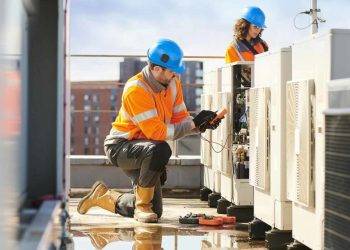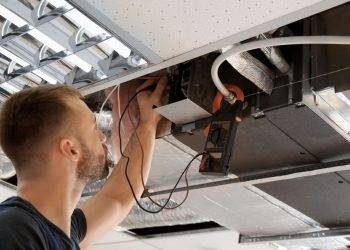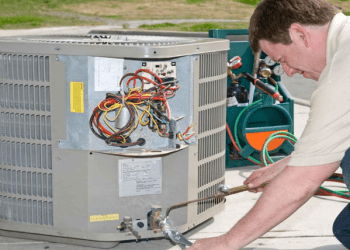In today’s competitive business environment, managing expenses is crucial for maintaining profitability and growth. One effective way to reduce costs is by cutting down on energy usage, which not only lowers bills but also supports environmental sustainability. By implementing smart energy-saving strategies, business owners can significantly reduce their overheads and boost their bottom line. This guide will delve into ten practical and effective methods to help you minimize energy consumption without compromising productivity or comfort in your workplace.
Solar Installation
Adopting solar energy is a standout option for reducing reliance on the unpredictable energy grid and shielding your business from fluctuating utility rates. By investing in solar panels provided through suppliers and installation experts like Revel Energy, you can generate your electricity, particularly during peak sunlight hours when demand (and costs) are highest. This local production of power significantly decreases your dependency on external energy suppliers, giving you greater control over your energy expenses. Moreover, solar panels are a long-term asset that, once installed, require minimal maintenance, securing an ongoing reduction in your monthly bills.
Beyond the tangible cost savings, solar installation presents unique financial incentives that make it even more appealing. Various federal and state programs offer tax credits and rebates that can substantially offset the initial investment in solar technology. For example, the Investment Tax Credit (ITC) allows you to deduct a significant percentage of your solar setup costs from your federal taxes, enhancing your return on investment. As you weigh the benefits, consider the added value of elevating your company’s sustainability profile, which can attract eco-conscious clients and partners. Embracing solar energy not only bolsters your profitability but also reinforces your commitment to a greener future.
Energy-Efficient Lighting
Replacing outdated lighting with LED alternatives stands at the forefront of energy savings due to LEDs’ exceptional efficiency and longevity. Unlike traditional bulbs, LEDs consume significantly less power, which directly reduces your electricity bills. Moreover, their extended lifespan means fewer replacements and less maintenance, translating to further cost savings over time. By installing LEDs, you not only enhance the brightness and quality of lighting in your commercial property but also enjoy considerable reductions in energy consumption.
To maximize the benefits of energy-efficient lighting, consider integrating motion sensors and automatic dimming features. These technologies ensure that lights are only in use when necessary, particularly in areas that may not be consistently occupied like storage rooms or bathrooms. This strategy avoids power waste and significantly contributes to lowering your overall energy expenditure. For large buildings or office spaces, conducting an initial lighting audit can determine the ideal distribution and type of lighting needed, allowing you to customize your installation for peak efficiency. By embracing these advanced lighting solutions, you’ll find that your energy management becomes more effective and sustainable.
Flat Roofing Solutions
Traditional flat roofing tends to absorb a significant amount of heat, leading to higher internal temperatures and increased reliance on air conditioning. To combat this, consider implementing energy-efficient flat roofing solutions that reflect, rather than absorb, this heat. Materials such as TPO (Thermoplastic Olefin) are particularly effective in deflecting sunlight, which helps maintain cooler interior environments. This not only reduces your air conditioning needs but also prolongs the life of your HVAC systems. By reducing wear and tear, you minimize long-term maintenance costs and ensure more efficient energy usage.
In addition to TPO, you can enhance your energy savings by applying reflective coatings to your flat roof. These coatings are specifically designed to bounce solar rays away from your building, further decreasing your energy needs for cooling. Such coatings may also qualify your business for tax benefits or incentives offered for energy-efficient upgrades. Consult with a commercial flat roof installation professional like the team at Fischer Roofing – Flat Roof Pros to see what solutions are available to help you cut down on energy expenses while enhancing the durability and sustainability of your commercial property.
Insulation Improvements
When it comes to cutting energy costs in your commercial building, insulation plays a pivotal role in preventing the transfer of heat through walls, ceilings, and floors, which directly impacts your energy efficiency. Unlike other systems, insulation acts as your building’s thermal shield, enabling you to regulate indoor temperatures without excessively relying on your HVAC system. By improving your building’s insulation, you can maintain a comfortable temperature year-round, thereby reducing your heating demands in colder months and cooling requirements when it’s hot outside. Opt for high-quality materials like spray foam or fiberglass, which are recognized for their superior ability to impede heat flow and air leaks, giving you unrivaled temperature control and energy savings.
You can also take insulation to the next level by upgrading your windows. Double-glazed windows, for instance, furnish an additional layer of thermal resistance that considerably minimizes heat transfer. Sealing leaks around window frames and doors contributes to preserving the climate inside your building, further reducing stress on your HVAC system. By lowering this thermal load, you not only cut down your utility bills but also enhance the longevity of your heating and cooling equipment. These tactical improvements will make a measurable difference in your monthly energy expenses, bolstering your bottom line while fortifying your commitment to sustainable business practices.
Energy Audits
Unseen energy waste can silently inflate your operational expenses, making it essential to discover where your commercial property might be leaking money. An energy audit is a powerful tool for business owners who want insight into their energy consumption patterns with a goal to trim hidden costs. By engaging in a professional energy audit, you can unveil inefficient practices or outdated equipment that contribute to unnecessary expenditures. An audit provides a comprehensive review of your lighting, HVAC systems, insulation, and office machinery usage, allowing you to spot and prioritize interventions that promise the highest savings potential.
Once armed with the insights from an energy audit, you are empowered to make informed decisions that address the specific inefficiencies unique to your operations. For instance, outdated lighting systems may emerge as significant consumers of power, offering an immediate area for improvement. You might find your HVAC system requires recalibration or upgrades to maximize efficiency. The detailed recommendations from an audit enable you to develop a tailored plan, targeting the biggest opportunity areas for reducing consumption and lowering utility costs. Ultimately, an energy audit not only helps you achieve immediate savings but also optimizes your property’s energy efficiency, supporting sustainable growth and a more robust bottom line.
Smart Building Technologies
Smart building technologies grant you precise, real-time control over your building’s systems, directly addressing the need for efficient energy management within your commercial space. These technologies make sophisticated use of sensors and automated systems, ensuring you only use energy when and where it’s necessary. By implementing occupancy sensors, for instance, you can automatically adjust lighting and HVAC levels based on whether a room is in use. This targeted approach eliminates waste and optimizes energy utilization, resulting in significant cost savings on your utility bills.
Beyond automation, smart building systems provide valuable insights by analyzing consumption patterns, which you can use to make informed adjustments and long-term improvements. Consider integrating smart meters, which offer detailed breakdowns of your energy use across different time periods and systems. With this data, you can identify peak usage times and high-consumption areas, enabling strategic planning and scheduling to further reduce costs. Additionally, by accessing these insights remotely, you maintain control from anywhere, enhancing operational flexibility and efficiency. Embracing these smart technologies not only streamlines your energy management but also positions your business as a forward-thinking leader committed to sustainable practices.
Optimizing Office Equipment
When you upgrade your office equipment to ENERGY STAR-certified models, you are directly investing in reducing your business’s energy overhead. Unlike older devices, these modern machines consume less power without compromising on performance or productivity. Opt for computers, printers, and copiers that bear the ENERGY STAR label, as they meet stringent energy efficiency guidelines set by the U.S. Environmental Protection Agency. This not only cuts your power consumption but also extends the lifespan of your office equipment, saving money in both energy and maintenance costs over time.
Moreover, encourage your team to adopt appropriate power management practices. Set all electronic devices to enter energy-saving modes automatically after periods of inactivity. This simple step can drastically cut down on wasted energy during off-hours. For example, using advanced power strips allows you to cut off phantom energy loads that many devices draw even when turned off. Additionally, educating your employees about the importance of turning off equipment when not in use fosters a company culture focused on sustainability and efficiency. Integrating these practices can lead to significant savings on your energy bill, while also contributing to environmentally friendly business operations.
HVAC System Updates
An old and inefficient HVAC system can significantly inflate your energy bills by consuming excessive power, making it imperative to consider upgrades tailored for optimal performance and cost reduction. By replacing outdated units with modern, energy-efficient models, you can ensure optimal cooling and heating while dramatically cutting down energy consumption. Incorporate smart thermostats that adapt to your business’s specific usage patterns, and automatically adjust temperatures for peak efficiency. The integration of these advanced temperature controls can lead to substantial savings, as they prevent energy waste by aligning operation times with actual need, rather than maintaining a constant, often unnecessary power draw.
Furthermore, regular maintenance plays a pivotal role in ensuring the efficiency of your HVAC system. Simple actions like cleaning or replacing filters every few months, and inspecting ductwork for leaks, can already improve airflow and efficiency, thereby reducing energy use. These steps, while straightforward, prevent your system from overworking and burning through unnecessary energy. Additionally, having a professional such as Comfort Tech Heating & Air Conditioning conduct periodic energy audits can identify any remaining inefficiencies and help you address them proactively. These updates and maintenance routines not only pave the way for lower operational costs but also extend the lifespan of your HVAC system, providing long-term financial and environmental benefits.
Water Heating Efficiency
Heating water is often one of the most significant contributors to a commercial property’s energy expenditure. For businesses aiming to cut costs, replacing traditional water heaters with tankless models can offer significant savings, as these heaters provide hot water on demand without constantly maintaining a reservoir. This switch can lead to a noticeable reduction in energy use because tankless heaters operate only when the water is needed. To further enhance efficiency, consider setting your water heaters to maintain optimal temperatures that meet operational needs without excess heat. This targeted approach prevents unnecessary energy consumption and helps maintain a more predictable energy budget.
Additionally, implementing a routine maintenance schedule for your water heating systems can extend their lifespan and ensure they run at peak efficiency. Regularly inspect and clean heating elements, and check for any mineral build-up that can impair performance. Also, consider insulating pipes and water tanks to minimize heat loss, which can contribute to energy waste. By taking these targeted steps, you’ll optimize the efficiency of your water heating system and move your business toward greater energy savings and sustainability.
Encouraging Behavioral Changes
Employee behavior can often lead to inadvertent energy waste, and addressing this is an opportunity for businesses to achieve significant cost savings. Unlike hardware upgrades, behavioral changes can be implemented immediately and at little to no cost. For instance, educating employees about the impact of energy conservation helps engage them in the effort. By fostering an environment where team members are encouraged to switch off lights and electronics when not in use or to rely on natural light whenever possible, you can significantly reduce energy consumption. A strategic approach could include setting specific office policies and implementing reminders, such as posters or digital notifications that prompt energy-saving practices.
To enhance engagement, consider initiating energy-saving competitions between departments, with small rewards for those who reduce their usage the most. These initiatives not only lower your energy costs but also promote a culture of sustainability within your organization. Moreover, encouraging remote work or flexible hours can further reduce the need for lighting, heating, and cooling during traditional office hours, translating into additional savings. By focusing on these internal practices, you’re not just reducing expenses—you’re investing in a long-term strategy that enhances both environmental responsibility and overall employee morale.
Improving business energy efficiency is not just about cutting costs; it’s about creating sustainable practices that benefit both the environment and the bottom line. Implementing these strategies requires an initial investment but leads to long-term savings and improved operational efficiencies. By focusing on specific actions such as upgrading HVAC systems or adopting smart building technologies, businesses position themselves as forward-thinking entities committed to sustainability and cost-effectiveness.








